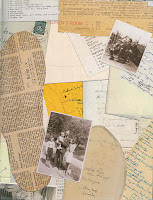Her grandparents, Fran and Frederick Hamerstrom, had received a letter from friends in Germany around Christmas 1946 saying that they were starving; they had no food, no clothing and no shoes. Her grandmother packed up a box with canned goods, socks, sweaters and her own winter coat and sent it off to these friends, the Kramers in Germany. She received a thank you letter from Dr. Kramer, but he asked that she send no more to them, that others needed help too. In his letter were foot tracings of ten families in need of shoes. Again, shoes that matched the tracings were found and sent off. More and more names and foot tracings were added to the lists that were sent from Europe.
By June 1947, the Hamerstrom’s had the tracings of 1,000 feet. Lita’s mother and grandmother knitted in the evenings to send socks with the shoes and clothing, and collected hand me downs from anyone willing to donate. Mrs. Hamerstrom and her daughter searched for shoes or boots everywhere, including unclaimed shoes in repair shops. The shoes were cleaned, new laces were put on them, socks and other items were enclosed in the packages. This went on until, finally, by May 1948 conditions in Europe were much improved and there were far fewer tracings being sent.
In the Author’s Notes, Judge also writes that Fran Hamerstrom and her husband were ornithologists and that they were part of the effort that fellow scientists had started to help those in need after the war. Altogether, over 3,000 care packages were sent to 15 European countries, thanks to these scientists.
This is a short, but very moving story. Watercolor is one of my favorite mediums and the watercolor illustrations in this book, done by Judge, are quite lovely, with an almost impressionistic feel to them. In sharp contrast, Judge has included collages of the very real foot tracing, photographs and letters sent to the Hamerstroms from Europe.
Lita Judge has an interesting website about One Thousand Tracings at http://tracings.litajudge.com/
One Thousand Tracings has received the following well deserved honors:
Book Links Lasting Connection of 2007
New York Public Library 100 Books for Reading and Sharing 2007
Society of School Librarians (SSLI) 2007
Cybil Award Finalist for Nonfiction Picture Books 2007
Winner of the IRA Children's Book Award 2008
ALA Notable Children's Book 2008
Michigan Notable Book 2008
NAPPA Gold Medal
Winner of the IRA Children's Book Award 2008
Jane Addams Children’s Book Award Honor 2008
NCTE Notable Children’s Books in the Language Arts
Bank Street Best Books of the Year 2008
CCBC Choices 2008
IRA Teachers' Choices for 2008
IRA Notable Book for a Global Society
Storytelling World Resource Award 2008
This book is recommended for readers’ age 5 to 9.
This book was borrowed from the 67th Street Branch of the New York Public Library.* One of the people the Hamerstroms developed a lasting friendship with due to this project was Dr. Konrad Lorenz, who contributed to the theory of imprinting. Imprinting occurs when young birds or chicks become attached to the first moving object they see after breaking out of their egg. Anyone who has sat through a Psych 101 class may remember the pictures of Lorenz and the baby ducks following him around.
Non-Fiction Monday is hosted this week by http://connect.capstonepub.com/




I'll look for this one--thanks!
ReplyDeleteYes, this book is definitely worth a read.
ReplyDeleteThank you for posting this blog. I saw something about this book a couple years ago, and could not remember the exact details. I couldn't remember the name of the book. The story line so took hold of me, though, that I wanted to find the book now. Your blog was the only one that came up when I Googled what I could remember. (Well, lots of stuff came up, but nothing I wanted--except for yours.)
ReplyDeleteThank You!